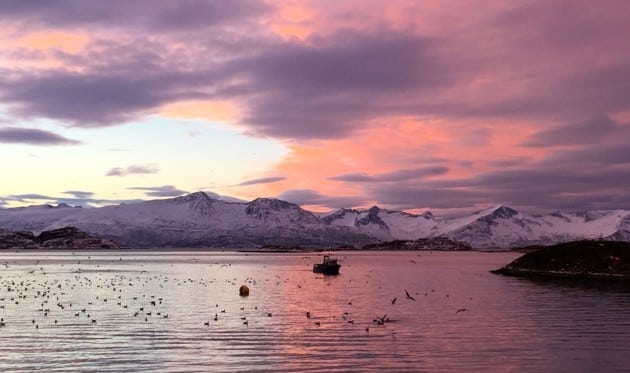November 19, 2017
For your Bits this weekend we get started with one of the newest fights for civil rights: the intersex rights movement. Intersex people are “born with some combination of chromosomes, hormones, gonads or genitals that defy social expectations of sex, including the expectation that sex is dichotomous.” That means that intersex people have varying gender identities (e.g. non-binary, female, or male), sexual orientations, and physical presentations which can include being born with XY chromosomes, internal testes, an enlarged clitoris that looks like a small penis, and a single urogenital opening. While intersex people have existed throughout history, technical advances in medicine since the 1950s have opened up the possibility of modifying people’s genitalia. This ability to “normalize” an infant’s genitalia is a point of great contention between the medical community and advocates for intersex rights centering on the question: should parents and doctors be able to change a child’s genitalia before they can provide informed consent?
Their Time

~ 31 Minute Read
“For a long time, most intersex people thought of their physical differences as something akin to a disease. Indeed, rather than using the label “intersex,” most physicians and many parents still prefer to talk about “disorders of sex development” — in other words, problems for doctors to fix. In 2000, the American Academy of Pediatrics went so far as to declare the birth of an intersex child a “social emergency.” (Since then, the AAP has grown more circumspect. “DSD may carry a stigma,” states a position paper adopted in 2006.)
But now activists are turning that argument around: Instead of talking about intersex people as medical subjects, they are speaking the language of identity, human rights and pride. They want doctors, parents and society at large to take a less rigid approach to sexual identity — and especially to reconsider the assumption that, to identify as a man or a woman, a person needs the gonads, genitals and chromosomes to match. “There is a much bigger focus now on intersex identity politics — on letting the world know that we are intersex people, as opposed to people with medical conditions,” says longtime activist Hida Viloria, a chair of the Organization Intersex International and author of a new memoir, “Born Both.” To Viloria, surgeries that aim to make children more conventionally male or female are “a gendercide, an institutional effort to erase us from society.”
There have been, in recent years, signs that the activists are making progress. In 2011, the United Nations’ Committee Against Torture released a statement critical of nonconsensual intersex surgeries; two years later, the panel went further, declaring that the surgeries often “arguably meet the criteria for torture.”
Even in the past few months, there has been growing momentum for intersex rights — on both the cultural and political fronts. In January, a prominent Belgian model named Hanne Gaby Odiele came out as intersex. In March, Nevada legislators introduced a bill that would ban surgeries on children too young to understand or consent to them, which passed the state Senate but died in the Assembly. (Lawmakers in Texas and Indiana have also introduced similar bills in recent years, though neither received a hearing.) In June, three former U.S. surgeons general released a statement condemning the surgeries. And in July, Human Rights Watch released a report in partnership with InterACT, urging “a moratorium on all surgical procedures that seek to alter the gonads, genitals, or internal sex organs of children with atypical sex characteristics too young to participate in the decision.”
These developments are in step with the larger disability rights movement, which argues for replacing assumptions of “bad-difference” with acceptance of “mere-difference,” in the terminology of philosopher Elizabeth Barnes. And they likewise echo the gay and transgender rights movements, which have risen to the surface of American politics and culture over the past generation. Now, in an era when society has proved open to revisiting other identities that were once considered shameful or taboo, is the intersex community finally on the brink of its own revolutionary moment — one that could transform what was a disorder into just another way for a person to be?”
Click To Read The Full Article At The Washington Post
Sign Up To Receive Weekend Bits In Your Inbox Every Sunday
Our next article takes a look at the Norwegian town of Tromsø; located north of the Arctic Circle, Tromsø experiences the “Polar Night” from November through January and the “Midnight Sun” during the complementary summer months. During the “Polar Night” the sun skirts the horizon between two to six hours each day, never fully rising and instead filling the sky with “sunrise and sunset-like colors,” yet many residents of Tromsø actually look forward to this time of the year. Researcher, Kari Leibowitz, was perplexed by residents’ ability to embrace winter and developed the concept of winter mindset to investigate their resilience. She found that people in Tromsø viewed the winter positively and looked forward to the opportunity to practice their favorite winter sports, enjoy the northern lights, and appreciate the warm glow of open-flame candles along every street.
The Norwegian Town Where the Sun Doesn’t Rise

~ 14 Minute Read
“Without pausing, Fern replied, “I wouldn’t necessarily say summer is the best season.”
Fern’s comment helped me to view my research question with a newfound sense of clarity. It dawned on me that the baseline assumption of my original research proposal had been off: In Tromsø, the prevailing sentiment is that winter is something to be enjoyed, not something to be endured. According to my friends, winter in Tromsø would be full of snow, skiing, the northern lights, and all things koselig, the Norwegian word for “cozy.” By November, open-flame candles would adorn every café, restaurant, home, and even workspace. Over the following months I learned firsthand that, far from a period of absolute darkness, the Polar Night in Tromsø is a time of beautiful colors and soft, indirect light. Even during the darkest times, there are still two or three hours of light a day as the sun skirts just below the horizon, never fully rising. During the longer “days” of the Polar Night, in November and January, the skies can be filled with up to six hours of sunrise and sunset-like colors.
It was now clear to me that my original research questions were colored by my own culturally biased perspective—in New Jersey, where I grew up, almost no one looked forward to winter, myself included (I even chose to attend college in Atlanta to escape the cold). In my experience, people simply got through the wintertime darkness on the way to a brighter, happier season. But in Tromsø, the Polar Night seemed to hold its own unique opportunities for mental and emotional flourishing.
I decided to include in my research a questionnaire that would capture the potential benefits of winter for the residents of Tromsø. But I quickly hit a snag: Aside from the standard assessment surveys used to identify Seasonal Affective Disorder, no other standardized psychological questionnaires about attitudes toward winter existed. (In general, psychology researchers prefer to use existing psychological measures, rather than create new ones, so that their work can be compared and contrasted to previous studies.) But while there were plenty of questionnaires that asked about seasonal depression, distress, and sleep disorder in winter, there were no surveys that made room for the potentially positive aspects of the season.
It was around this time, as I was investigating psychology graduate programs more thoroughly, that I flew back to the U.S. for a conference, a wedding, and a visit to Stanford University. While at Stanford, I met with Alia Crum, a professor of psychology, to learn more about opportunities for graduate students in her Mind & Body Lab. Crum’s research focuses on subjective mindsets, which she defines as “the lenses through which information is perceived, organized, and interpreted.” As we chatted about her research and my own work in Norway, Crum suggested that mindsets might play a role in the wintertime flourishing I was observing in Tromsø.
Crum follows in the footsteps of the psychologist Carol Dweck, whose work focuses on the psychological concept of “mindset.” In her research and her book, Mindset: The New Psychology of Success, Dweck details the ways a growth mindset (the belief that traits like intelligence and talent can be developed through sustained effort over time) leads to greater success than a fixed mindset (the belief that individual qualities are set for life). Those in a fixed mindset, she argues, often fail to see feedback as an opportunity for learning, and are more likely to view criticism as a personal attack. Conversely, those in a growth mindset tend to be more open to learning from their mistakes, taking risks, and pursuing self-improvement. Dweck’s belief, now widely accepted, is that mindset can be changed, and that a person can move from a fixed mindset to a growth mindset.
Crum’s work expands on this idea by investigating how mindset influences not only achievement and success, but also physical health. In one of her studies, for example, people who had a positive mindset towards stress, viewing it as productive rather than debilitating, had healthier levels of the stress hormone cortisol. In another, hotel employees who believed that cleaning rooms was good exercise saw decreases in their body fat and blood pressure, compared to those who simply viewed it as work. As her research illustrates, mindsets aren’t only “fixed” or “malleable:” They can be positive or negative, constructive or destructive.
Which led me to the question: Can we measure positive or negative mindset toward winter? And might this wintertime mindset have something to do with Tromsø residents’ psychological well-being during the Polar Night?”
Click To Read The Full Article At The Atlantic
Sign Up To Receive Weekend Bits In Your Inbox Every Sunday
Your last Bit for the weekend takes a look at what liberals and conservatives in the United States get wrong about Islam. Ali Rizvi shares his experience as an Atheist Muslim who grew up in three very different Muslim-majority countries. Rizvi acknowledges the “hard truth” that there is a lot of violence in the Quran and that “ISIS often puts out very accurate statements quoting the Quran that completely fit their actions.” At the same time, he stresses the difference between Islam and Muslims; Islam is a religion with a specific holy text and related cultural traditions; Muslims are people who identify with that culture, but their beliefs are not monolithic with some taking the texts literally while others do not believe a word of the text. Through this dichotomy he explores a range of topics from the appeal of fundamentalism, the era of Trump, and the reformation of Islam.
An atheist Muslim on what the left and right get wrong about Islam

~ 24 Minute Read
“Sean Illing
There’s a lot more to be said about this, but I want to refocus us on the political questions. I’ll be honest: I came to this conversation with some trepidation. I’m of the left, but I do believe there is an element of the left that struggles to talk honestly about the problems in the Muslim world, in part because so many feel obliged (rightly, I think) to beat back the bigotry on the right and also because religion is rarely the only variable driving behavior.
But when I saw your tweet the other day claiming that the left was wrong about Islam and the right was wrong about Muslims, that felt like a good way into this difficult debate. Can you tell me what you meant by that?
Ali Rizvi
I think the left has a blind spot when it comes to Islam and the right has a blind spot when it comes to Muslims. When Christian fundamentalists like Pat Robertson say something that’s homophobic or misogynistic, people on the left descend on them like a ton of bricks. They’re very comfortable with criticizing and satirizing fundamentalist Christianity. But when it comes to Islam, which has many of the same homophobic and misogynistic teachings, they throw their hands up, back off, and say, whoa, hold on, we must respect their religion and culture.
Sean Illing
You seem to applaud the intent here but still think it’s ultimately counterproductive.
Ali Rizvi
I get that it comes from a good place. I’m a liberal myself, and I vote liberal. It’s part of our liberal conscience to protect the rights of minorities, as they should be protected. But that doesn’t mean we must protect and defend all of their beliefs as well, many of which are just as illiberal as the beliefs of Christian fundamentalists.
This is very frustrating to our liberal counterparts in Muslim-majority countries, who are fighting fundamentalist Islam the same way that liberals here fight fundamentalist Christianity, and they’re even risking their lives for it. Many have died for it. Yet they hear their liberal counterparts in the West calling their ideas “Islamophobic.” This is a devastating double standard for them.
Sean Illing
And what of the right?
Ali Rizvi
Those on the right paint all Muslims with the same brush. The title of my book speaks to millions of people in the Muslim world who are atheist or agnostic but must publicly identify as Muslim or they’d be disowned, ostracized, or even killed by their families and governments. They’re atheist in thought but Muslim by presentation. They’re living a contradictory existence. Hence the title of the book.
They retain the Muslim label because the governments and Islamist groups in their countries won’t let them shake it off. Well, now, with Trump’s Muslim ban, especially the first one he proposed as a candidate in 2015, Trump won’t let them shake it off either. Blanket bans like that include many people like me, because we have Muslim names and come from Muslim-majority countries.”
Click To Read The Full Article At Vox.com
Thanks for checking out the Weekend Bits! If you enjoyed these Bits, why don’t you share it with a friend? We appreciate your support and as always, Contact Us online or send us an email at [email protected].
Have a great rest of your week!